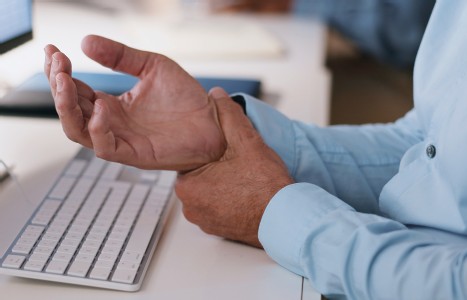It is estimated that 61% of patients with CTS avoid taking surgical options due to postoperative complications and costly surgical procedures. Chiropractic care offers a comprehensive and effective treatment for carpal tunnel syndrome, addressing the condition from multiple angles. Recent studies also have unveiled a game-changing adjunct to chiropractic treatments for CTS: nerve flossing.
Red Light / Infrared Therapy for Foot Pain
- Light therapy is non-invasive, painless, effective, dependable, and very easy to administer. The treatment cycle is only 20 minutes. Even better, it is an unattended modality.
- A number of manufacturers of red light / infrared therapy systems have designed pads especially for treating the foot.
- There are three ways to utilize the pads. You can 1) treat in-office, 2) rent pads to patients or 3) sell the pad systems to patients for in-home use.
With all the walking, running, hiking, exercising, dancing, stair climbing, and jumping that your patients may do throughout their lives, is it any wonder that at some point they may experience foot pain?
According to a 2014 survey conducted for the American Podiatric Medical Association (APMA), “[A]lmost 8 in 10 Americans have experienced a foot problem, and half say it has impacted their quality of life.”1 In fact, “Half of all adults say that foot pain has restricted their activities – like walking, exercising, working, or playing with grandchildren – in some way. For those with chronic foot pain, that number jumps to 83 percent.”2
Why Red Light / Infrared Therapy?
As a practitioner, you know foot pain should be addressed as soon as possible, as pain in one or both feet can potentially lead to impairment of foot function, which in turn may increase the risk of falling. But foot pain does not have to restrict daily life.
So, if you or a loved one suffers from any type of foot pain, or if your patients do, rather than treating foot pain with over-the-counter pain and anti-inflammatory medications such as ibuprofen, or prescription nonsteroidal anti-inflammatory drugs (NSAIDs), or even corticosteroid injections for chronic foot pain, why not try red light / infrared therapy?
Light therapy is non-invasive, painless, effective, dependable, and very easy to administer. The treatment cycle is only 20 minutes. Even better, it is an unattended modality. And because it has been proven to have “almost complete lack of reported adverse effects,”3 practitioners can confidently leave patients on their own, in office, after the therapy pads are put in place and the system is turned on. Most light therapy systems automatically turn off as soon as the 20-minute session ends. That means it requires limited staff time to manage the modality.
Pain Relief Plus Healing Support
Light therapy can not only help relieve all types of foot pain quickly and effectively, but due to the beneficial chemical processes released within the cells during treatment, red light / infrared light therapy may also accelerate healing.
Scientific studies show that “[r]adiation of tissue with light causes an increase in mitochondrial products such as ATP, NADH, protein, and RNA.”4 And its release of nitric oxide increases circulation, so blood high in oxygen and nutrients can flow more freely into the local area, reducing pain and supporting the body’s natural healing.
It may seem amazing, but it’s true that “low doses of light have demonstrated the ability to heal skin, nerves, tendons, cartilage and bones.”5 And over time, as nerves heal, numbness decreases and sensation in the foot returns. Studies show that pain in any part of the foot, from the toes to the Achilles tendon and up to the ankle, will respond well to light therapy.
Light Therapy Foot Pads
A number of manufacturers of red light / infrared therapy systems have designed pads especially for treating the foot. Often, pads are constructed from neoprene. Neoprene allows the pads to easily bend and have Velcro straps, allowing for precise adjustment for each patient. Some manufacturers have even coated one side with silicone for comfort and ease of cleaning.
There are three ways to utilize the pads. You can 1) treat in-office, 2) rent pads to patients or 3) sell the pad systems to patients for in-home use. Four suggested configurations that are excellent for treating foot issues are discussed below.
Foot / Ankle Pads: This uniquely shaped multi-section pad is flexible and versatile, allowing it to be used in two ways: extended or folded over. When extended, the pad can cover the bottom of the foot from the toes to the back of the heel, continuing up over the calf area. When folded over, this pad can cover the toes and foot like a boot, including the top of the foot, sole, heel, and ankle.
This pad makes for an excellent home unit. Why? Its length and unique top and bottom also allow the pad to be wrapped around the hand with the forearm resting on the pad, down the spine or the thigh and leg, or over a shoulder. Hands can be placed on the top and bottom sections.
Foot / Calf Pads: These pads can treat the sole of the foot and the back of the calf simultaneously. Like the foot / ankle pad, this pad can be used in two ways: under the foot and extending up the back of the calf, or folded in half to treat both the top and bottom of the foot.
Long and Narrow Pad: These highly flexible long and narrow pads allows them to be used in multiple ways. You can place the pad over the top of the foot and wrap it under the sole; place the pad under the sole of the foot and let the rest of the pad travel up the heel and into the calf area; or place the pad horizontally, putting both feet on top to allow the toes or the heels to be treated simultaneously.
This pad can also be used to treat other areas. Its length makes it easy to wrap around the elbow or knee; the jaw and the forehead; flat down the back; or across the shoulders, calf, stomach, or hip.
Small Rectangular Pads: The size and rectangular shape of these pads make them ideal for foot treatment. Just place the foot on top of the pad, or put the pad over the toes or strap across the ankle with Velcro. This pad contains LEDs with a mix of red and infrared wavelengths. Its small size makes placement extremely easy, so it can also be used on practically every other area of the body: the wrist, hand, neck, arm, elbow, shoulder, stomach, back, calf, thigh, or jaw, making this one pad the perfect therapy system for the entire family.
Kick Foot Pain Out
Foot pain does not have to limit the quality of life for you or for your patients. Red light / infrared therapy can make a big difference when it comes to maintaining a comfortable, mobile and active lifestyle.
References
- “Public Opinion Research on Foot Health and Care: Findings From a Survey of 1000 US Adults.” American Podiatric Medical Association.
- Day B. “New Survey Reveals Majority of Americans Suffer From Foot Pain: Ailments Widespread, Yet Few People Address Issues.” American Podiatric Medical Association, May 19, 2014.
- Hamblin MR. Mechanisms and applications of the anti-inflammatory effects of photobiomodulation. AIMS Biophysics, 2017;4(3):337-361.
- Chung H, et al. The nuts and bolts of low-level laser (light) therapy. Ann Biomed Eng, 2012 February;40(2):516-533.
- Cotler HB, et al. The use of low level laser therapy (LLLT) for musculoskeletal pain. MOJ Orthop Rheumatol, 2015;2(5):4.



